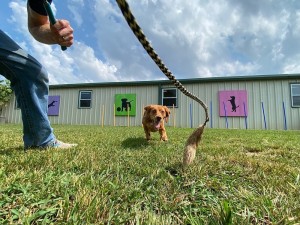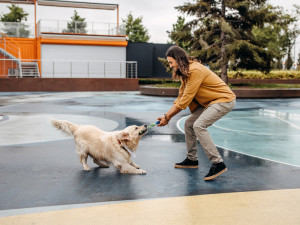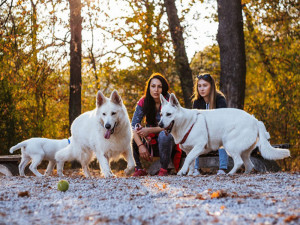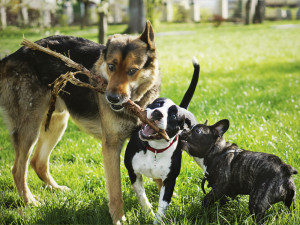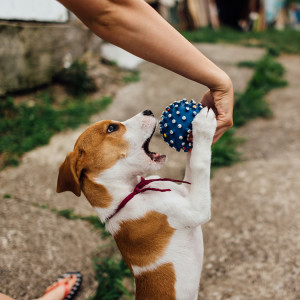Shelter Play Groups Provide Enrichment to Pups
Shelter play groups enrich lives and reduce stress for dogs in shelters.
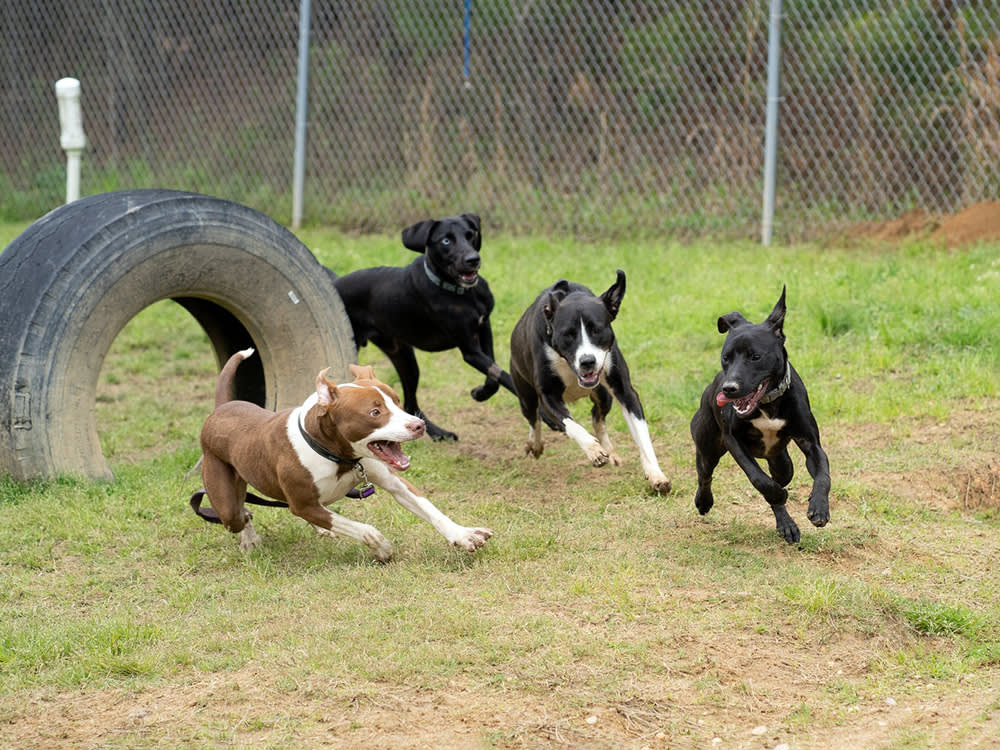
share article

Your pet wants you to read our newsletter. (Then give them a treat.)
Jimmy didn’t know it, but he had a death sentence hanging over his head. The barrel-chested, squat stray, ears cut to look fighting fierce, had failed a dog-to-dog temperament testopens in a new tab at Rochester Animal Services, a city shelter with a high intake rate. But this sunny morning in upstate New York, Jimmy got a second chance. He was escorted to the shelter play yard, where about 20 dogs tore around, chasing and jumping on one another, taking breaks to cool off in a plastic kiddy pool.
Jimmy leaned over and licked the volunteer trying to fit a muzzle over his broad head. Then, the Pit Bull mix was released into a pen, where he was reunited with his sister.
Firefighters had found the pair roaming the city streets and brought them to the shelter. The siblings sniffed one another, tails a-blur. A volunteer released an unneutered male into the pen. Jimmy showed no signs of aggression. Muzzle removed, he stood calmly while the dog playfully jumped on his back. After romping in the larger yard with the rest of the dogs, Jimmy was deemed a sweet boy. A few days later, he was adopted.
Shelter Life is Rough
“Many dogs in shelters are misdiagnosed as dog-aggressive,” says Aimee Sadler, founder of Dogs Playing for Lifeopens in a new tab (DPFL), a program that uses playgroups to exercise, socialize, evaluate, train and save as many dogs as possible. “My number-one goal is to train dogs effectively, and then get them out of the shelter as quickly as possible,” says Sadler bluntly. “Dogs behaviorally deteriorate when they have been in a shelter too long.”
There is a reform movement underway to improve the quality of life for animals in shelters, and playgroups are pivotal to this effort, says Natalie DiGiacomo, shelter director of the Humane Society of the United States. “Play enriches dogs’ lives and reduces stress so their true personalitiesopens in a new tab show,” she says.
Whether it’s an anxious giraffe in a zoo or a stressed-out dog or cat in a shelter, providing some type of enrichment is essentialopens in a new tab to the well-being of animals in captivity, says Vint Virga, DVM, author of The Soul of All Living Creatures. “The whole idea of Dogs Playing for Life is wonderful,” says Virga, who has worked with dogs and cats with behavioral issues and is currently a behavioral consultant to zoos and wild animal parks. “It gives dogs an opportunity to have more social interaction as well as to practice appropriate play behavior in a controlled setting.”
Dogs need both dog-dog play and dog-human play, observes Virga. The two serve different purposes. “If you try to make the enrichment one-on-one with the keeper, you are not coming close to offering what dogs can offer one another. As much as we try, we still don’t understand the nuances of dogs’ cues, signals, and behaviors, whether they are running, tumbling or dashing.” And while many dogs will happily fetchopens in a new tab a Frisbee for us, dog-dog play is less object-focused, more rough and tumble, Virga says.
Dogs Playing for Life Program
Sadler, too, has extensive experience working with domestic and wild animals, including a job monitoring the training of animal actors for the American Humane Association and training animals for television and music videos. Sadler says she has applied those 25-plus years spent interacting with dogs, horses, marine mammals, and wild animals to developing Dogs Playing for Life.
Yet, Sadler didn’t set out to become a shelter playgroup guru. She was working as a private dog trainer when a client hired her to train dogs at the Southampton Animal Shelter in Hampton Bays, N.Y. She had three hours to work with 25 dogs.
“I thought, What is the most efficient way to help them get all their ya-yas out so they will be better prepared for their learning session?” Sadler recalls. She decided to first let them play together in the shelter yard. Not only was the training successful, but the dogs were quieter and calmer when they returned to the shelter.
How Dogs Playing For Life Helps
Decrease dog-to-dog and on-leash reactivityopens in a new tab.
Decrease territorial behavior within the shelter.
Increase a dog’s ability to focus in training.
Maximize staff time — kennels can be cleaned while dogs play.
Burn up mental/physical energy through intense social interaction.
In 2005 Sadler continued running playgroups at a much larger shelter, Longmont Humane Societyopens in a new tab. It wasn’t until she began receiving enthusiastic feedback from shelter staff that she fully realized the program’s potential. “People were inspired. That was invaluable in stimulating change. It allowed them to see for themselves, instead of [me] trying to convince them that what I was doing was correct.”
Sadler’s reputation grew, and she began speaking at major animal welfare conferences. She met shelter directors who were trying to reduce their euthanasia ratesopens in a new tab and hired Dogs Playing for Life to train their staff and volunteers to run playgroups. Many shelters that could not afford either Sadler’s services or the cost of a play yard received grants from Animal Farm Foundationopens in a new tab in Bangall, N.Y., a nonprofit that has advocated for the humane treatment of Pit Bull-type dogs for nearly 30 years.
Dogs Playing For Life Training
A typical Dogs Playing for Life training begins with a classroom presentation on the theory behind the play. Next, it’s out to the play yard for a hands-on training session. Runners bring the dogs from the kennel to the yard and, at the instruction of the Dogs Playing for Life lead handler, move dogs from one pen to another if the chemistry isn’t working.
Deciding which dogs will play well together is an art, not a science. “We make decisions based on their body languageopens in a new tab and how dogs already in the yard are reacting to them,” Sadler says. “I look for dogs to tell me a lot about each other. Any dogs who need smoothing out, we send away and then circle back to them.” Because many shelters receive new dogs every day, staff will muzzle a dog if there is a concern that the dog might behave aggressively in playgroup.
The two pillars of any effective playgroup, says Sadler, are a human group leader who is calm, confident and willing to be assertive with the dogs, and dog helpers who Sadler refers to as “rock stars,” dogs who are good communicators, confident and super friendly. They teach the fearfulopens in a new tab or aggressive ones how to play — how to pick up cues that other dogs are feeding them.
The group leader closely observes the play, while allowing dogs to be dogs — in other words, to work out minor squabbles for themselves. Mountingopens in a new tab, bared teeth, and raised hacklesopens in a new tab are all appropriate ways for dogs to communicateopens in a new tab, says Sadler. The leader should intervene only if there are clear signs of aggression. “You are looking to see if there are stimulus control issues preventing dogs from responding well to one another,” she explains. “You are watching how they respond to the other dogs’ social cues.” Should the play turn ugly, the group leader is well prepared. They wear a handyman’s belt stocked with a filled spray bottle, a can of coins, and an air horn, all devices to distract an errant dog.
Not all animal welfare professionals embrace this approach, but Sadler is steadfast that corrections are as necessary as positive reinforcement. “I think there is an irrational fear of the use of correction — that it will do damage to the animals. When I watch animals communicate, they are correcting one another all the time, effectively, without damage being done. We use reward for behaviors we want to happen more, aversion for things we want to happen less.”
Some shelter administrators are terrified there will be dog fights. Sadler straightforwardly addresses the issue: “If you do playgroup on a daily basis, you will have altercations. That’s part of working with animals.” She stresses that injuries to dogs and people have been minimal over a seven-year period at Longmont. Once a shelter is holding daily playgroups, Sadler and her team can be hired back for more advanced training.
Play Brings Impressive Results
Mike Fry, executive director of Animal Ark Shelteropens in a new tab, a no-kill shelter in Hastings, Minn., was ahead of the playgroup curve — his staff had been exercising small numbers of dogs in its play yard for years. But after hearing Sadler speak multiple times and watching her videos, he decided he needed to “think bigger.” Animal Ark has been running large playgroups, and the results have been dramatic, says Fry.
“Dogs who showed barrier aggression in the shelter, barking when people or dogs passed their cage, were not aggressive when playing in a natural environment. Dogs who are not well socialized to people learn by watching other dogs interact with people in the playgroup. Dogs learn better from other dogs.”
Playgroups also save money and limited manpower. Instead of one person walking one dog, you have a few people, often volunteers, exercising many dogs. “A dog going for a walk on a leash is very restrained,” Fry says. “Compare that to 12 dogs ripping, running, rolling around, and doing circles over each other. You are using fewer resources and getting better results, which is what all nonprofits should strive to do.”
Playgroups have resulted in an increase in live release rates (adoptions and dogs taken into foster homes), a trend that benefits animal welfare overall, says Kristen Auerbach, director of communications and outreach of the Fairfax County Animal Shelteropens in a new tab in Fairfax, Va. Thanks to its playgroup, which Sadler helped them start last year, Fairfax was able to move more dogs in a shorter space of time and had room to take in several hundred dogs from area shelters. Fairfax also reduced its reliance on rescue groups by 50 percent, freeing up those rescues to pull dogs from other shelters.
Since the play yard opened, Auerbach says she looks forward to Saturdays, when the public is invited to visit. “When people go to the kennel, they feel sad. They’re trying not to cry,” she says. “When they go to the playgroup, they are laughing and excited. Many people go home with a new dog — dogs who maybe you wouldn’t have noticed in the kennel. They’re not beautiful, maybe they’re older, but they’re adopted based on personality, and that’s what we want.”
Statistics on live release rates from shelters with playgroups:
Longmont Humane Society had a 76 percent canine live release rate (LRR) in 2004; since operating a playgroup in 2001, the shelter has maintained a LRR in excess of 95 percent.
Southampton Animal Shelter had a LRR of 73 percent in 1998. Since the shelter became privatized and added a playgroup in 2010, it has maintained a LRR of more than 95 percent.
Edmonton Humane Society (Canada) reported an 8 percent increase in LRR in the first 30 days after DPFL training.
Austin Pets Alive! reports that without the DPFL program, they would not be able to meet the needs of the dogs they pull from the municipal shelter, which would result in city-wide LRR dropping from 90+ percent to less than 85 percent.
Donna Jackel
Donna Jackel is a freelance journalist specializing in animal welfare, health and caregiving.
Related articles
![two woman at dog park talking while watching their dogs play]() opens in a new tab
opens in a new tab13 Common Dog Behavior Myths Overheard at Dog Parks
Many pet parents share information at the dog park, but is the information always accurate?
![Three dogs biting a stick.]() opens in a new tab
opens in a new tabSome Like It Rough: Playing Vs. Fighting
Two animal behavior experts agree it’s usually play fighting. Here’s how you can tell.
![A dog reaching up to grab a blue ball out of a woman's hand.]() opens in a new tab
opens in a new tabPlaying With Dogs Improves Their Training Success
Post-training play may extend a dog’s memory of previously learned behaviors by up to a year.
![Scared tan dog against brick wall background]() opens in a new tab
opens in a new tabDoes Your Dog’s Growl Mean Aggression?
Remember, dogs have more than one emotion.
